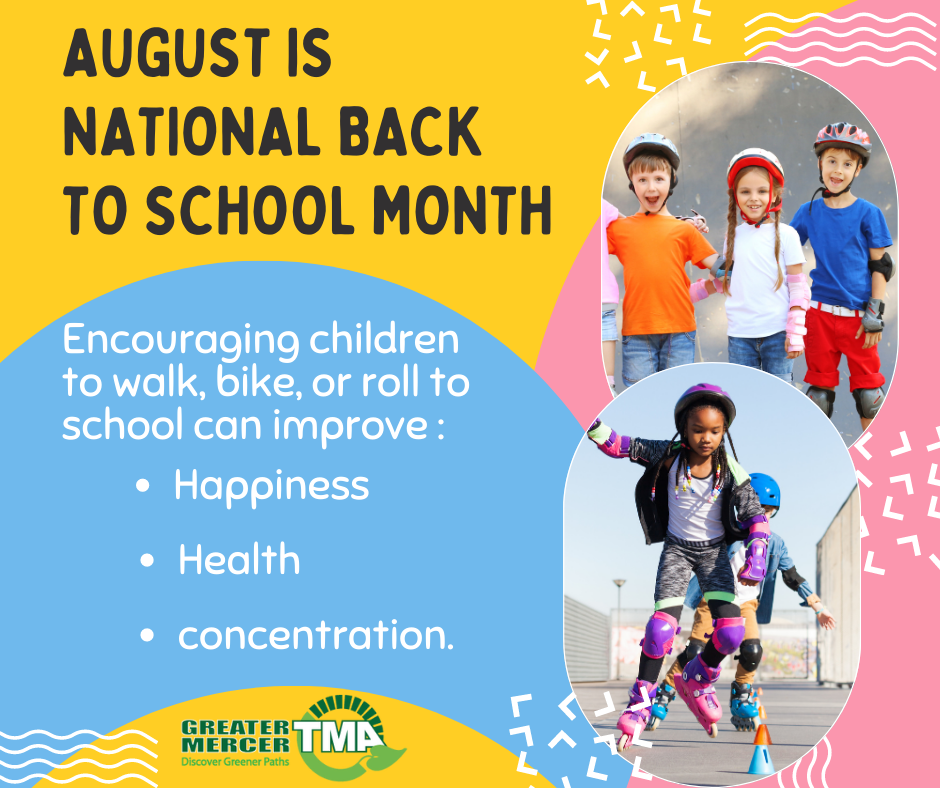
Did you know that August is National Back to School Month? As we prepare to head back to school, our primary focus tends to be acquiring the necessary supplies, like backpacks, clothes, and other essentials. In addition to shopping for new clothes and supplies and planning school schedules– planning how to get to school is also essential. Encouraging children to walk, bike, or roll to school can improve their happiness, health, and concentration.
- Happiness
Did you know that physical exercise can help reduce the risk of depression in children ages 6-13? According to the CDC, it’s true! Additionally, a 2020 study from the Journal of Environmental Research and Public Health states, “children and adolescents who are more physically active showed better general mental health and fewer mental health problems.”
- Health
The Centers for Disease Control and Prevention (CDC) recommends that children get at least one hour of physical activity daily. Walking or biking one mile to school is an excellent way for kids to get the suggested activity. According to the CDC, children who walk or bike to school can experience improvements in their bone health and their cardiorespiratory and muscular fitness. Additionally, the research also suggests that children who walk or bike to school are more likely to remain active throughout the day. These individuals are even more likely to continue this active lifestyle into adulthood. (Source: National Library of Medicine).
- Concentration
According to a study, children who walk or cycle to school instead of being driven by their parents tend to have better concentration. Moreover, the benefits of physical activity during childhood can continue through life. According to a study by Science Daily, people who exercised during childhood tend to perform better on cognitive tests, regardless of age.
Spending quality time with your children and offering them valuable tips to help them get to school safely, energized, and ready to learn will help ensure a smooth transition into the new school year. Please encourage your children to make walking or biking to school their usual routine by taking a stroll or bike ride with them. We have compiled some resources to help you ensure that your children can walk or bike to school safely.
- Ensure younger children know their home address and phone number and who to call if they need help.
- Map the route and practice walking or biking to school with your child. Ask GMTMA for assistance in finding a route.
- Practice walking safety skills – you can find a refresher here.
- Practice biking safety skills – you can find a refresher here.
- Organize a Walking School Bus and use the Walking School Bus App to organize walks to/from school. Parents can create walking groups, invite neighbors to join, plan walks to and from school, assign parent leaders to walk with students, group text within the app, and alert parents when students arrive safely. The app is available here.
- Or organize a Bike Train- a group of children biking to school accompanied by an adult. You can also use the Walking School Bus App to organize and manage a bike train.
- Ask us to help with a school travel plan in your community. GMTMA works with schools and towns to create a plan to improve pedestrian and bicycle travel to and from school. A School Travel Plan identifies current walking patterns, where students would walk and bike if they could, and what changes need to be made so that students can and will walk and bike to school. The plan identifies short and long-term solutions and is supporting material for grant applications.
- Ask us to help with a walkability audit in your community. Students, parents, and interested community members can get involved in improving the walkability and bikeability of their community by conducting “audits” of the area around the school. GMTMA can provide audit checklists and facilitate this outdoor activity.
- Consider organizing a Bike and Pedestrian Safety presentation at your school to educate students on safe walking and biking practices. GMTMA offers customized presentations to suit different age groups and grade levels.
- Organize a bicycle rodeo/skills clinic in your community. These events usually occur during or after school, in a parking lot, where children can practice bike riding, reinforce and practice basic biking safety skills, and learn how to fit a helmet properly. GMTMA is available to assist with the organization of these events and may even be able to provide helmets.
We hope that these tips and resources will assist you in creating a plan for walking or biking to school. If you have any inquiries, please feel free to reach out to us. Enjoy walking and biking to school!
Resources:
https://www.sciencedaily.com/releases/2021/06/210618134038.htm
https://www.who.int/europe/news/item/17-02-2021-who-reviews-effect-of-physical-activity-on-enhancing-academic-achievement-at-school
https://www.fatherly.com/news/want-your-kid-to-do-better-in-school-bike-walk-there
https://www.bloomberg.com/news/articles/2013-02-05/the-link-between-kids-who-walk-or-bike-to-school-and-concentration
